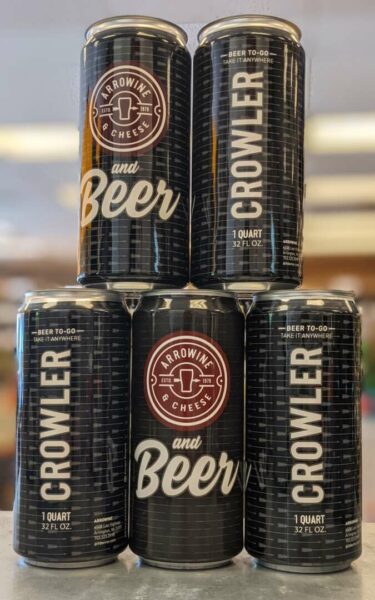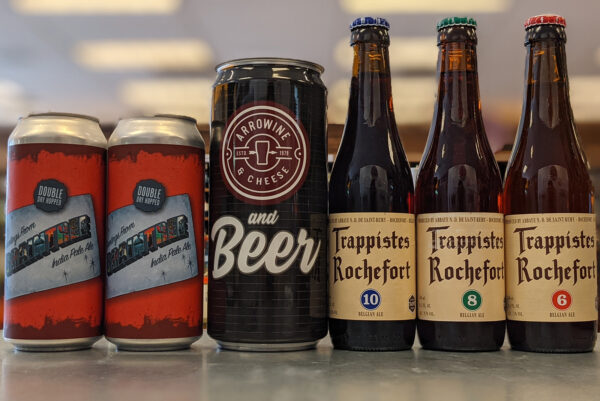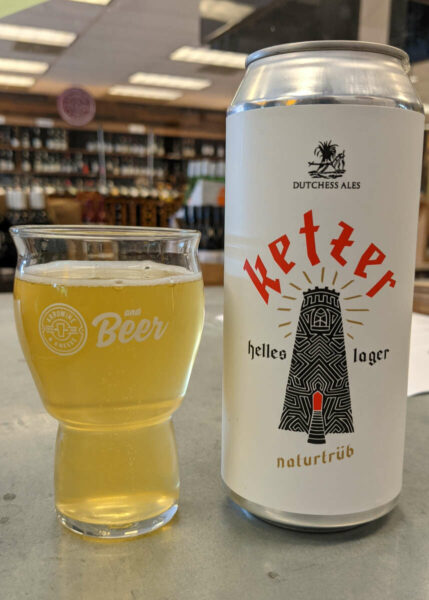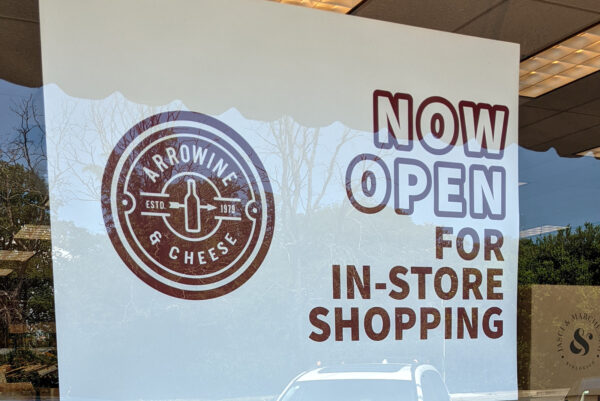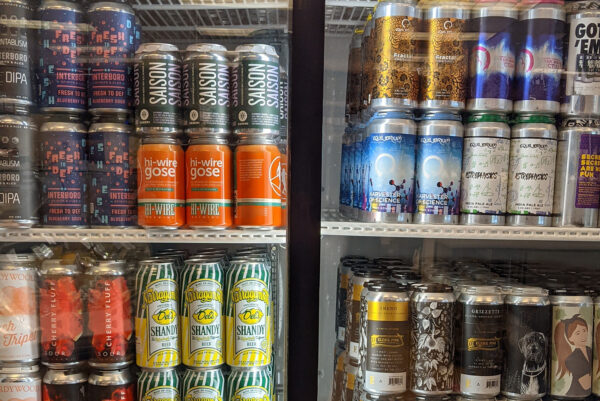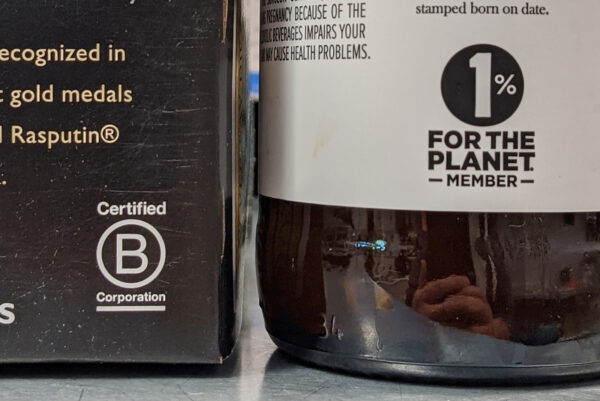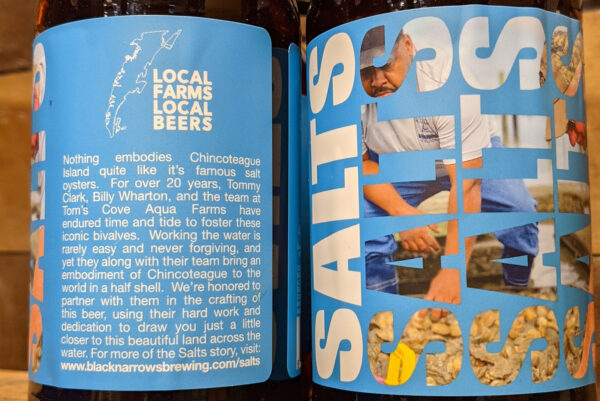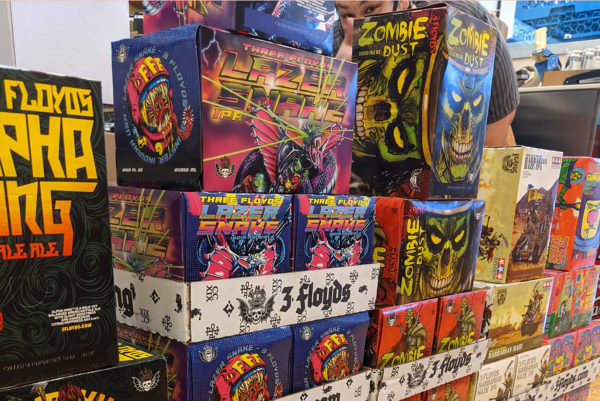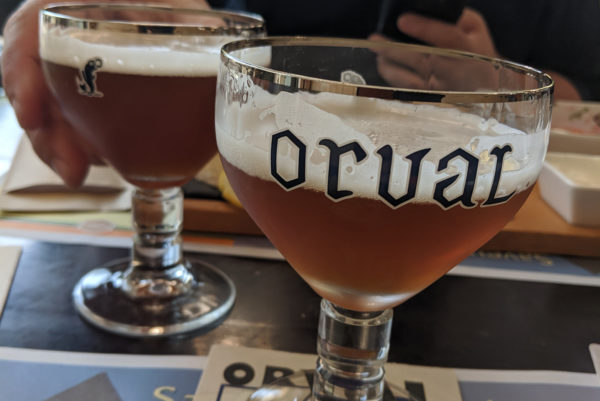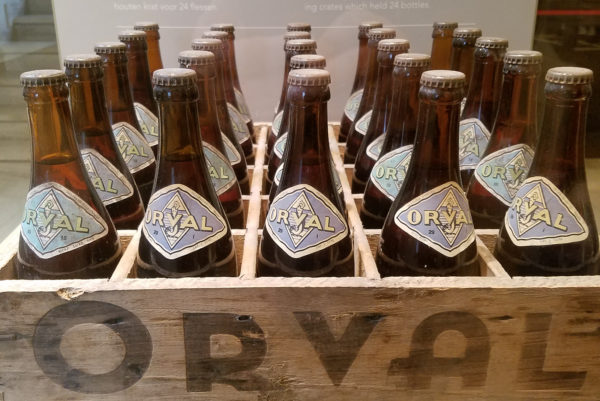
This sponsored column is written by Todd Himes, beermonger at Arrowine (4508 Lee Highway). Sign up for the email newsletter and receive exclusive discounts and offers. Order from Arrowine’s expanding online store for curbside pickup.
“Aroma of skunk, musty, can be similar to burned rubber or cat musk.”
That definition of the lightstruck off-flavors in beer comes directly out of the Cicerone study resources.
But what is lightstruck beer? When certain hop compounds react to UV light, they create 3-methyl-2-butene-1-thiol, or MBT, which you may know as the culprit behind that odorous character often found in some “top-shelf” imported lagers — or late nights on some dark country roads.
Brown glass bottles would filter out most of that UV light where green and clear bottles would let UV wavelengths pass through with greater ease and thus green and clear bottles received a reputation for “ruining” many a beer and changing the flavor of what its brewers would have intended. For years I bought into that — it even became one of the tenets of my strong support for putting more beer into cans. If some light was bad why not eliminate all light? Somewhere along the way, though, I’ve been introduced to thinking those green bottles unfairly got a bad rap.
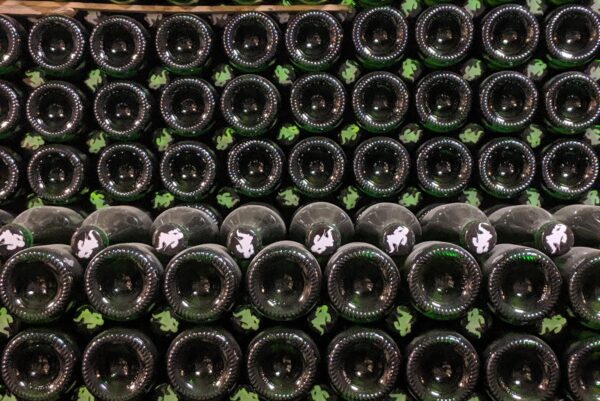
Many of my favorite Belgian breweries have been bottling their beers in green glass for longer than I’ve certainly been drinking them. Even after I’d learned the hardline “green is bad,” I longed to try the lambics of Cantillon, Drie Fonteinen and Boon, all of which were shipped across the sea in verdant vessels.
The first Belgian in green that crossed my lips was Saison Dupont. Upon uncorking that bottle, I was struck by the aromas that were decidedly “farmy” before farmhouse ales were truly on my radar. But nowhere was I thinking about skunks or tire fires, just-cut hay, horse stalls, and dank grasses. Saison and lambics became some of my favorite styles, and I even saw a noble art in what I saw as the unknown and unpredictable effects of wild yeasts, spontaneous fermentation and wood aging.
Despite being a popular way of packaging these types of beers in Europe, here in the United States, the classic brown bottles prevailed even as more breweries were experimenting with old traditions in brewing. That changed and much of the credit is given to Jester King in Austin, Texas, when in 2016, they began packaging some of their mainstay beers in green glass bottles for sale in their tasting room. The bottles that were destined to leave their gorgeous property were still being packaged in brown glass. (Full disclosure: Jester King’s brewery is quite possibly my favorite place in the world and that was before I got married there in 2019.)
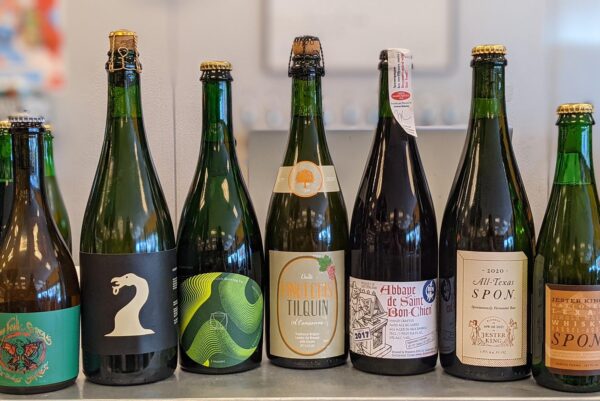

This sponsored column is written by Todd Himes, beermonger at Arrowine (4508 Lee Highway). Sign up for the email newsletter and receive exclusive discounts and offers. Order from Arrowine’s expanding online store for curbside pickup.
Hey, everybody! It’s Your Beermonger here, Todd, from Arrowine.
As I write this, I sit in front of possibly one of my favorite parts of our store. You might think I, as a former cheesemonger, would gravitate toward the cheese case here, though my heart really lies toward the end of the case with all the cured meats. (If you don’t already know from our Weekly Whey-In emails, the Olympia Provisions Landrauchschinken is back in stock and still as fun to pronounce as ever!) Or, you might find me browsing the Spanish wine section and occasionally hovering around the Txakoli, dreaming about a trip to San Sebastian and eating tinned fish and Iberico ham. However, where you are most likely to find me in the store at any given moment would be here in front of our 12 taps of beer that are available to go in the familiar form of growlers and the, as I am finding out, slightly less familiar form of “crowlers.”
The crowler is a 32-ounce can we are able to fill and seal here in-store. This makes the crowler a single-use carrier and, with no way to reseal, you’ve got to enjoy all 32 ounces in one sitting. They will last a little bit longer than a resealable glass growler will before opening.
The crowler technology was first introduced by Oskar Blues back in 2013, which as you may remember, laid claim as the first craft brewery to release beer exclusively in cans. The format spread fairly quickly throughout brewery taprooms but less so into retailers. Crowlers carry many of the advantages that cans have — they are lighter weight, airtight when sealed properly, don’t allow light to reach the beer and are much less susceptible to damage. That unbreakable factor also allows a Crowler to go with you poolside, to the beach or on a hike in the woods. It does take a little bit more effort to crush a 32-ounce can, but it’s worth it to not lug an empty glass jug around with you.
The crowler is designed to be a one-time-use vessel, as opposed to the near-infinite use of glass growlers (you know, provided that they don’t fall over in your trunk and get banged all around). That also means you won’t, like me, end up with a large collection of glass growlers taking up space and collecting dust. Sure, they do make great souvenirs from breweries far away, and they can also be a great way to show support for your favorite locals. But, in many cases, you end up with way more than you can conceivably use at any time.

This sponsored column is written by Todd Himes, beermonger at Arrowine (4508 Lee Highway). Sign up for the email newsletter and receive exclusive discounts and offers. Order from Arrowine’s expanding online store for curbside pickup.
Happy upcoming Fourth of July weekend, everybody! We’ve got a lot to celebrate this week, and for many of you, this will be a great chance to get together a little like old times. For me in the summer, that means breaking out the grill and having a few brews. In the spirit of that celebration and to toast the incredible fireworks show put on down the street by my neighbors, I’ve put together some beer and food pairings based on what might be on your menu this Fourth.
The classic all-American hot dog calls for another classic with the American lager. I like to keep it fairly simple and avoid anything too hoppy or complex. The Bingo Lager is an overwhelming favorite around here and would excel in this application. Based on the Helles style, you’ve got your balance and high drinkability here. Bonus points are rewarded for being a great value for a six pack of tall cans.
I love, love, love a porter with cheeseburgers off the grill. Especially if you’re cooking over charcoal, the roasty flavor of a porter pairs perfectly with the slight char of meat. The trick to this pairing is to not go too heavy and skip anything too adjunct laden. (Sorry coffee or coconut, you’re delicious sometimes, but I’m staying unburdened here.) My choice happens to come right from our backyard in the way of Port City’s Porter. Even at 7.2%, this dark ale won’t put you down for an early bedtime as long as you sip — not chug.
If veggie burgers are on the menu, it can be tough to give one recommendation that fits all the styles. If you’ve got something that looks and tastes more like meat, then I’d suggest the above porter or perhaps a dark lager. If you’re going with something that’s not hiding the fact that it’s full of veggies, a slightly more flavorful ale like a saison is a good choice. In the summertime heat, a grisette is a fantastic option, and we happen to have one that I thoroughly enjoy from Elder Pine. The Grizzette is going to be very similar in style to a saison but with generally a lower amount of alcohol for a much more sessionable choice.
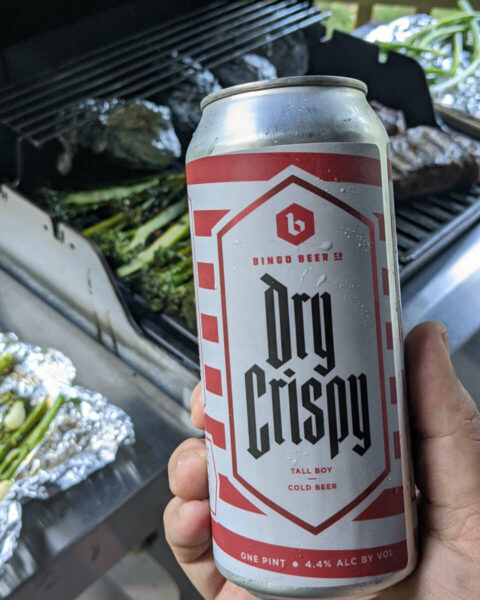
Grilled chicken is another fantastic Fourth of July option. It also lends itself to a number of different preparations. If you’ve got a simple grilled chicken breast, I like an American wheat beer, particularly with a little citrus to brighten things up, and I’d recommend grabbing the Lost Coast Tangerine Wheat. Maybe you’re thinking of adding a sweet barbecue sauce to some grilled thighs in which case I’d switch over to a classic California Common or Steam beer. When in doubt, I say go for the classic Anchor Steam (now in cans with the divisive new labels as well!). If wings or any other liberal use of the Buffalo-style sauce is in the plans a West Coast IPA is going to help accentuate that heat, and I couldn’t recommend the Front Royal Gracious Living any more highly.

This sponsored column is written by Todd Himes, beermonger at Arrowine (4508 Lee Highway). Sign up for the email newsletter and receive exclusive discounts and offers. Order from Arrowine’s expanding online store for curbside pickup.
In my last column, I mentioned one of the great things about getting people back into the store has been the questions I’ve been fielding from all of you, and the conversations it has allowed me to get started.
My weekly beer newsletters I send out frequently feature a section belovedly titled “Arrowine House of Lagers,” and that is driven, in part, by the increase in both supply and demand. But honestly, I’d be doing it even if it was just for my own personal amusement. There is, over and over, one subsect of lagers that seems to beguile folks: the Kellerbier. Even a few years ago the style remained relatively obscure here in the U.S., and traditional German versions rarely traveled this far.
Let’s make one thing clear: All Kellerbiers are not created equal. Kellerbier means simply “cellar beer,” and it is a style of lager that would have traditionally been matured (or lagered) inside of an oak cask stored in a cave or cellar. Inside of that cask, the beer would remain unfiltered and unpasteurized. and in this case, it would have had its bunghole (yes, they really call it that) left open to the surrounding cellar air. It would have carbonated itself gently and naturally but not to the level that it would have if it had stayed in a closed container trapping the CO2.
While this openness does allow the flow of air from inside the cave, it is completely different from an open or even spontaneous fermentation, so don’t expect fruity open-air pale ale esters or the wild funk of a lambic. Served directly from the cask, this beer would be cloudy, lightly carbonated and perhaps softer than a longer aged traditional lager. Outside of that requirement, any lager could be considered a Kellerbier if it was served in this method, right?
So wait, does that mean that my New England unfiltered hazy IPAs could all be considered Kellebiers as well? Nope — completely different styles. What about a cask of English Best Bitter? That’s closer, but Germany’s brewing traditions utilized their many natural caves for lagering as opposed to the British traditions of warmer fermenting ales. Perhaps you’re inducted into the Cult of Rothaus and love their unpasteurized Pilsner. You might be thinking unpasteurized, lager this HAS to qualify — but alas no. That doesn’t mean this increasingly more popular style isn’t without its variances.

This sponsored column is written by Todd Himes, beermonger at Arrowine (4508 Lee Highway). Sign up for the email newsletter and receive exclusive discounts and offers. Order from Arrowine’s expanding online store for curbside pickup.
We’ve been having a busy few weeks here at Arrowine since we’ve opened back up our doors. We’ve seen (the top half of) so many familiar faces coming through the doors, and the response has been incredible.
Our online ordering system is still up and running, and I want to take a moment to thank everyone who has been using the website to place orders. We will not be making any changes to the online ordering system, so if that’s what you’re comfortable with, please continue to place your order online.
However, I know many of you are visual shoppers. I’ve been hearing it all day for the past few weeks — how great it is to be able to come in and check out all the beers, look at the cheeses (in general, if I get free second in the store, it’s probably spent looking in the cheese case) and browse through the wines. There is just something about seeing all of your options right in front of you that the online shopping experience cannot offer. Most of all the in-store experience allows me to do what I do best — which is monger.
A monger is, depending on your definition, either someone who is a broker or dealer of things or someone who promotes a specific activity, especially one that’s undesirable. That’s your difference between a fishmonger and a warmonger. I hope I get lumped in with the former, but to say Carrie Nation or John Lithgow’s Rev. Moore from “Footloose” being a beermonger is definitely the latter.
Our cheesemongers probably have it a little easier by comparison. (The pure joy on most people’s faces when you tell them you’re employed as a cheesemonger is truly a sight to see and almost makes me miss being back there slinging goudas and brie.) The truth of it is, though, that most of the mongers I know do so much more than that. When we’re not actively helping customers, we are constantly honing our crafts, which means learning everything we can about our products and making sure they are kept in the best condition possible.
With the return of in-store shopping I get to answer all those questions that can be hard to find online like, “Which of these beers have Citra hops in them?” or “Do you have any beers with a fish on the label?” and “What beer goes best with mulligatawny soup?” By the way, the answers are “lots,” “yes,” and “I like a dark lager.” Most of those fall flat in the online space and certainly don’t allow for much in the way of follow-up.
As far as keeping beers in the best condition, you’ll see me rotating products so nothing is sitting around for too long, and one of my favorite new things using the extra space in our keg cooler for cold back-stock storage. This allows for many of the beers that come into the store cold to stay cold until you buy them. This is extremely important for many of the hazy IPAs and sours with fruit purees added that are so popular these days. It also keeps the growing supply of unfiltered lagers that we are able to get our hands on cold at all times.
I look forward to seeing as many of you as possible for in-store shopping soon. Please bring me your best questions (nothing too tricky though — Your Beermonger hasn’t had a week off work in almost two years now!) or just come in and tell me about the beers you’ve been drinking!
Hope to see you soon.

This sponsored column is written by Todd Himes, beermonger at Arrowine (4508 Lee Highway). Sign up for the email newsletter and receive exclusive discounts and offers. Order from Arrowine’s expanding online store for curbside pickup.
This week I was lucky enough to find myself over at Nationals Park to watch a game and, for professional purposes, to have a hot dog and beer.
It wasn’t my first trip to the stadium this year, but it was the first time I sat up in the newly reopened 300 level, which was much closer to where I’d say my usual seats are (also from where I saw T-Swizzle back in 2015.) However, the closest District Drafts stand was all the way down by the 100s, and because this beer purchase was for Professional Research Purposes™, I made the walk down and back up, which gave me time to think about sessionable beers.
Session beers are hard to nail down in an exact definition. Originating in British and Irish drinking culture, these beers are characterized by being low in ABV (at Arrowine, we’re aiming for sub 5%) and high in flavor and refreshment. You might find stories of workers being allowed drinking “sessions” while working, a “session” meaning anytime you get together to have more than one beer. And you might think that concept exists so ubiquitously that it doesn’t need to have its origins pinpointed. For many folks in the U.S., before the growth of craft beer in America, this is what all beers were. Even now many of the imperial stout and double IPA drinkers I know will reach for light lagers when extended days of drinking are on the docket.
The walk back up the twisting switchback ramp was even more inspiring with a Port City Optimal Wit and a Right Proper Raised by Wolves in hand. My wife and I always toast Opening Day with an Optimal Wit, since the story goes that it was Port City’s Bill Butcher who did some heavy lobbying to get the District Drafts stands into the park. Plus, it is a delightful beer that I could drink anytime, anyplace. The Raised by Wolves stands out as being packed with flavor, extremely aromatic and, because I had sessions on my mind, the 5% ABV really swayed me. Maybe it was because it was a weeknight. Maybe it was because I was ordering the 23-ounce large size of each. Or maybe it was because of the time I spent this week tagging items in our online store to build out the session beer section of our website. Whatever the reasons, drinking something delicious but not Barrel-Aged-Imperial-Coffee-Marshmallow delicious was the raison d’etre.
Never really going out of style, the concept has made many a push in my time of beermongering. You have a strong British influence that was present in corners of the aughts, the rise of session IPAs that followed the “extreme beer” era and even now the number of large craft producers introducing low calorie, sub-4% IPAs geared toward expanding the audience of craft. Add on top of that the rise of craft lagers that are following the hazy IPA wave that has been washing over the industry, and we might be poised to enter a session renaissance.
If you’ve got a favorite sessionable beer, drop a comment below and look out for it possibly coming to our shelves.

This sponsored column is written by Todd Himes, beermonger at Arrowine (4508 Lee Highway). Sign up for the email newsletter and receive exclusive discounts and offers. Order from Arrowine’s expanding online store for curbside pickup.
One thing you might not always think of when you finally get the chance to step back into our store here at Arrowine (it is coming soon, I promise!) is that we sell agricultural products. The milk for our cheeses comes from well cared for and respected grazing animals, and the wines we sell are made great by growing high-quality grapes in the vineyards — not in a lab where they can be manipulated and fussed with (highly technical terms).
With Earth Day having passed us this week, I thought it might be interesting to take a look at a number of the environmental initiatives our brewery friends are undertaking to have a positive impact on our world ecosystem.
Two somewhat newer things you might notice on a label or package these days are Certified B Corporations and 1% for the Planet. Some of the 1% for the Planet member breweries we stock are Maine Beer Company, Vasen Brewing and Bearded Iris Brewing. These companies not only make financial donations and adhere to sustainable practices in the brewhouse, but they also volunteer their time to different environmental initiatives.
Certified B Corps undergo a certification process that looks at not only their environmental impact but also their social impact. We have beers on shelves from Certified B Corps Allagash Brewing and North Coast Brewing, but you’ll also see the B logo in our freezer from Jeni’s Splendid Ice Creams and in the cheese case on Vermont Creamery products. Allagash also recently started up a recycling co-op for some of the waste products of the brewing process that require special processing. Maine Beer Company and Bissell Brothers, located in the immediate area, also joined in. This echoes a similar program that Bell’s Brewery announced earlier this year that will hopefully inspire more of these collaborations.
Many of our local breweries also make use of local ingredients in order to drive home their commitment to reducing environmental impact. If you’ve recently held a can or bottle of Port City Optimal Wit, you may have noticed that it’s brewed with 100% Virginia wheat grown in the Northern Neck. You’d be forgiven if you haven’t stared at the breakdown of estate-grown vs. regionally sourced malts on any of the bottles from Wheatland Spring Farm + Brewery — the beers alone are worthy of all your attention — but if you’re going to geek out a little over that information then we are going to get along great.
One of my favorite locavore beers, though, has to be Salts from Black Narrows. This gose-inspired tart wheat ale harvests natural yeast from oyster shells and also combines a portion of oyster liquor into the brew. The results are not only bright, briny and refreshing, but it also changes throughout the seasons to truly reflect the terroir of Virginia’s Eastern Shore.
Another essential input to the brewing process that doesn’t even end up in the beer is energy. In cities such as D.C., it can be difficult to grow your own ingredients for your beers — but that doesn’t mean you can’t create your own resources. Atlas Brewing’s cans proudly state that they are “Solar Powered Beer,” and if you ever visit their Ivy City taproom, you can see a display on the wall that shows what power is being harvested from the sun, what is being used by the brewery and what is going back to the grid. Their uptown neighbors Right Proper’s Brookland production facility reduced its energy use by installing LED lights and offset half its energy consumption with a solar canopy out front and an array of panels on the roof. In Vermont, Hermit Thrush Brewery uses wood pellets to power its brewhouse created from sawdust from the local timber industry that would otherwise be considered waste.
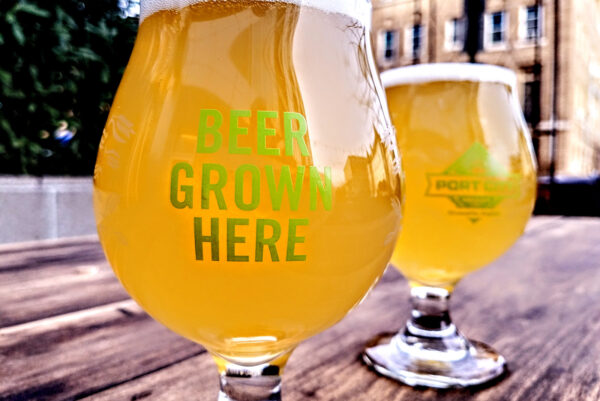
I’ve got a collection on the Arrowine online store of all the products covered here. Apologies to anyone I may have missed, but thank you for doing your part as well. If you know anybody I’ve overlooked, please let me know in the comments! Whether it’s a brewery we carry here at the store or not, it’s great to point out and applaud these breweries for their efforts. Cheers!

This sponsored column is written by Todd Himes, beermonger at Arrowine (4508 Lee Highway). Sign up for the email newsletter and receive exclusive discounts and offers. Order from Arrowine’s expanding online store for curbside pickup.
This has happened to us all, I am sure.
It’s a little after noon one weekday, and you see the notification pop up on a group text you’re in with a few old coworkers: “I’m adapting Julia Child’s Beef Bourguignon recipe to beer and not sure what type to sub in for the wine.” Will this beer cook down to be too bitter? Would a sour mirror the acidity found in the wine? Could this beer be too light and be overpowered by the beef? Maybe. The answer to all of these questions really is maybe.
Cooking with beers can be tricky, but there are a few general guidelines you can follow to set yourself up for success.
First, don’t cook with something you wouldn’t want to drink on its own. If you didn’t like it the way it was brewed to be enjoyed, then you’re probably not going to like what it does in your recipe.
Secondly, don’t start off too bitter — not just hops but intensely roasty beers as well. Long cooking times and reductions will concentrate and intensify those bitter flavors. I strongly suggest skipping over coffee beers, too. The high heat brings out extra bite in the coffee like an over extended brewing time would.
Lastly, it’s better to skip anything you’d describe as subtle or delicate flavor-wise, as those flavors can be masked by other ingredients or lost in the cooking process.
So now that we got the negatives out of the way, let’s talk about the things you can and should definitely try.
Sweeter malty beers will concentrate over time and make an excellent choice for braising and stews. I love De Struise Pannepot, a really unique take on a Belgian Dark Strong Ale that veers towards Imperial Stout. One of the most decadent things I have ever eaten was at Nuetnigenough in Brussels where they served braised beef cheeks that had slow cooked in that beer.

Rich chocolatey stouts can be incredible in baked goods like brownies.
Steamed Mussels in Lambic are always delicious as well. I’ve enjoyed anything from a classic Gueuze with butter and garlic to Framboise with bacon. Recently, when it was a little too cold to break out the smoker, I even added a bit of Aecht Schlenkerla Rauchbier Urbock to some onions, mustard and a pork shoulder and was very pleased with the results after a few hours in a 275°F degree oven. The smokiness wasn’t overpowering at all, and it even cooked down to a rich umami-packed sauce that would be just as good in vegetarian chili as it was here.

Anybody out there have a great recipe for cooking with beer they want to share with me? I’ve been wanting to try swapping out a little bit of the water in my pizza dough recipe for a crisp pilsner.
Oh, and if you’re curious what I suggested for the Bourguignon, I pushed for an Oud Brun with its maltiness and tart acidity, but those are getting harder and harder to find. I couldn’t even offer a classic example here, but the friend in question settled on a Right Proper Baron Corvo, which is a pretty damn good choice I’d say.

This sponsored column is written by Todd Himes, beermonger at Arrowine (4508 Lee Highway). Sign up for the email newsletter and receive exclusive discounts and offers. Order from Arrowine’s expanding online store for curbside pickup.
It’s coming to my attention that I have a problem with pop culture, namely that I cannot stop referencing it in my everyday conversations. It hasn’t gotten quite to Abed from “Community” levels of bad yet, but I might be on my way.
I find myself particularly immersed in music pop culture, and a lot of my timeframe for those references is the ’80s and ’90s. The impetus for me realizing this was becoming a problem was when I was having a perfectly normal conversation with a coworker this week, and a little light goes off in my head. Next thing I know, I’m searching YouTube for a commercial Nirvana did with Bobcat Goldthwait.
Luckily for me, this ’80s and ’90s pop culture knowledge does leave me primed to understand where a lot of these beers are getting their names these days…
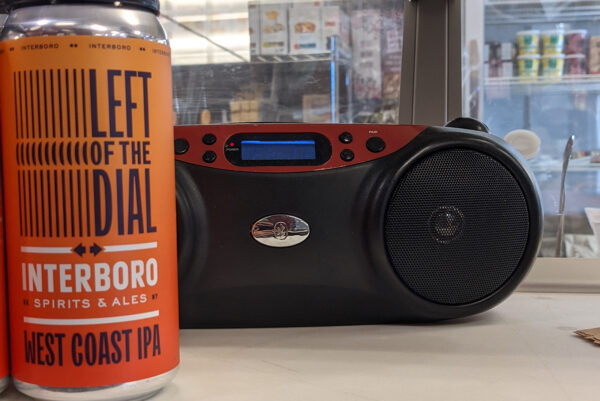
Poring over a beer list these days can sometimes be pretty intimidating. Occasionally you’re presented with a beer that is straightforward and clear about what it is. Take, for example, Hardywood Pils. You’ve got the name of the brewery, the style of beer — and that’s it. Then you’ve probably got your fair share of puns, a few ten-cent words and the ever increasingly more popular short paragraph. But the ones that jump out at me are those names that drop a quarter into the jukebox of my mind.
Just this week we got in a new West Coast IPA from Brooklyn’s Interboro called Left of the Dial, and when I see the can, I can hear in my head the strum of The Replacements. DuClaw just released an orange and vanilla infused IPA called It Was All A Dream-sicle, and there is absolutely no way I can read that without following up with Word Up magazine.
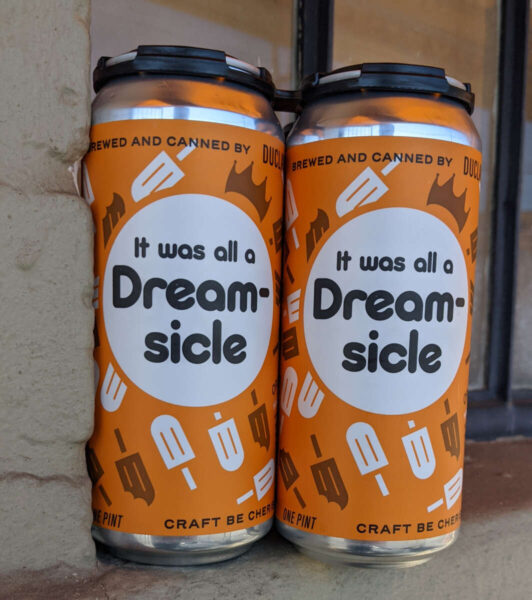
The alternative rock and hip hop of the ’90s I grew up on definitely seems to overlap with brewers, marketers and others involved in the naming process of these beers. You see some folks that might skew a little older — I see you, Bluejacket with your Mexican Radio and Love Cats — and of course the more “of the moment” names as well. You also see someone like Atlas swelling with hometown pride with their Dance of Days Pale Ale, which pairs well with house shows according to the can!
To celebrate a few of the musically inclined beers we have in stock right now, I’ve put together a little Beermonger’s Playlist on Spotify. Feel free to have a listen.
If you’ve got a favorite beer I missed, let me know below. I skipped a few I really enjoy that aren’t in stock now (sadly no Permanent Funeral just yet), but I know there’s some great examples out there.

This sponsored column is written by Todd Himes, beermonger at Arrowine (4508 Lee Highway). Sign up for the email newsletter and receive exclusive discounts and offers. Order from Arrowine’s expanding online store for curbside pickup.
Your old, jaded Beermonger here was all set to pen an ode to the simple yet complex joys of the humble lager and its recent return to respectability within the craft beer culture at large. We’re talkin’ beers driven by high-quality ingredients and centuries-developed techniques, not by hops that form their own sentient amorphous T-2000-esque ooze or the effects of non-nutritive cereal varnish on head retention.
Instead, within the past week, we saw one of the most long-awaited brewery launches (technically a re-launch but it’s been a LONG time) from 3 Floyds out of Munster, Indiana. You might know them for their bright comic book inspired artwork, their frequent collaborations with heavy metal bands, their annual Dark Lord Day festival or, if you’re the type of beer drinker who frequented RateBeer or Beer Advocate in the late aughts, then you know them as The Best Brewery In The World.
That last bit was where I first really was introduced to the brewery. Dark Lord used to sit atop pretty much any list of Best Beers in the World that was floating around at the time. I was convinced, in my mind, that the praise was based highly on the fact that you couldn’t actually get the beer. (The more things change the more they stay the same.) Dark Lord may not have invented the “beer you can only get for one day a year,” but it sure took the beer release to a new level. It was a beer geek party that included bottle shares that were seemingly the stuff of legends.
At the time, the full lineup was very much the same way. They distributed to a very small number of states. (At one time, that distribution reached the East Coast but as demand went up, they pulled back to a very small handful of states.) For years I would visit my in-laws in Chicago and carry an extra suitcase on the way out in order to bring back plenty of Zombie Dust. The beers they produced were very in vogue for the time of Extreme Beer, high ABV, high IBUs, aggressive names and labels — worlds apart from the soft, pillowy hazy IPAs, triple fruit smoothie sours and every type of candy bar in the grocery store checkout aisle pastry stout that rule today.
I was so impressed by Alpha King the first time I had it because, in my mind, it sat perfectly in the space between two of my other favorite beers at the time, Sierra Nevada Pale Ale and Dogfish Head 60 Minute. To see that beer being one of the hottest items on the shelf in 2021 tops my list of unexpected events of the year so far. Let that sink in for a moment. Here, in this calendar year, it’s people losing their minds for bitter IPAs you can see through that has caught me the most off-guard.
Here at Arrowine we got in our first shipment of 3 Floyds last week, and it sold out before I could even send a newsletter out. Luckily we got another shipment this afternoon, so it looks like the Midwest Masters of Hops are going to be here to stay.

This sponsored column is written by Todd Himes, beermonger at Arrowine (4508 Lee Highway). Sign up for the email newsletter and receive exclusive discounts and offers. Order from Arrowine’s expanding online store for curbside pickup.
Hello, readers of ARLnow.
This is your new Arrowine Beermonger, Todd. I figured, rather than the typical introduction, I’d let you get to know me a little bit more by talking about one of my favorite beers. (Three sentences in and you’ve already learned that I sometimes take the long way to get to a point.)
The concept of a desert island beer seems pretty simple, right? You’re stuck on an island, and you have only one beer to drink until someone conceivably comes to rescue you — or you live out the rest of your days in an introvert’s paradise. Are you thinking of your all-time favorite that you can enjoy over and over, never tiring of the taste? Or maybe you’re looking to pamper yourself in this hypothetical by loading up on that rare bottle you’ve never gotten your hands on.
Personally, I’m looking for something that will be versatile enough to cover all the bases and that will be continually developing so I’m always on my toes. Enter: Orval.
Brasserie d’Orval is a Trappist brewery located within the walls of the Abbaye Notre-Dame d’Orval in the Gaume region of Belgium. Gaume is about as far away from Brussels as you can get while still being in Belgium. And Orval is about as different from your typical Trappist beer while still being a Trappist beer. (Trappist beers are categorized by the monks making it rather than the style or ingredients.) You might be thinking of the beautiful simplicity of Westvleteren Blond or the rich caramelized fruits of Chimay Grande Reserve, and most Trappist beers resemble one of the archetypal styles (Singel, Dubbel, Tripel, Quadruppel).
Orval, on the other hand, at its most simple, is described as a Belgian pale ale, but even that gets a few twists and turns thrown in like dry-hopping and my favorite part: an intentional dosing of wild yeast, Brettanomyces bruxellensis, at bottling. This last addition is what makes Orval my ideal desert island beer. That “Brett,” as best known to its friends and enemies, will continue to ferment the bottled beer for years to come, which introduces differing levels of funk in every bottle, an increase in carbonation (the reason it comes in such heavy bottles) and has the added benefit of scavenging oxygen.
At a young age, the beer is dry, fruity and very refreshing, but as it ages, it becomes bone dry, introducing more spicy notes and far more complexity. To speak to the joys that the full spectrum of this beer brings me, I cite two examples. First, one of the many highlights of spending my honeymoon in Belgium was exploring the grounds of the abbey and sitting in the cafe down the road to enjoy an Orval far fresher than any I’ve ever seen in the United States. And second, I once found two bottles in a store that had been bottled on Feb. 29, 2012. I immediately bought them with the intention of opening one on each of the subsequent Leap Days in 2016 and 2020. (Best laid plans and all but that didn’t work out.)
I was inspired to make this the topic of my first column since we’ve got more Orval arriving at Arrowine today. If you’ve never tried it, I highly recommend picking up a bottle or two with your next order.
Drop a comment below and let me know what your desert island beer would be!
Cheers,
Todd


